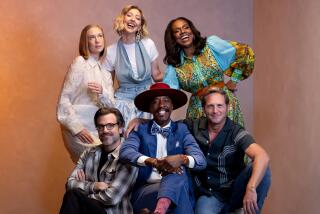‘Fractured Fairy Tales’ Delight Audiences : Ex-Teacher Finds True Calling as a Master Storyteller
- Share via
Ed Stivender is a master storyteller, but he says his mother would much rather he’d chosen to spend his days delivering sermons instead of one-liners.
“I grew up in Springfield, Pa., near Philadelphia,” he says. “My mother, a devout Irish Catholic, wanted me to be a priest. But my father, a Baptist, said to me, ‘Son, never get a job where you have to wear a dress to work.’ ”
So, he compromised.
Instead of becoming a priest, he went to Notre Dame, got a master’s degree in theology and became a teacher. But teaching, as it turned out, was only a brief detour on the road to storytelling.
This ancient and time-honored road took Stivender, a slender, black-haired man with pixie eyes and a droll wit, to Jonesborough, Tenn., for the National Storytelling Festival.
Followed by Fans
More than 4,000 people from around the country flocked to the popular festival. Many of them, like Cincinnati residents Linda Frankel and daughter Shaina, self-described “storytelling groupies,” followed Stivender from tent to tent as he told his “fractured fairy tales,” intensely personal and slightly twisted versions of such classics as “Cinderella” and “The Princess and the Frog.”
Stivender, who now lives in Philadelphia, is one of about 200 full-time professional storytellers to emerge in this country during the last two decades. These latter-day bards follow a vague circuit of schools, workshops and benefits, plus a growing number of storytelling festivals. They run the gamut from the traditionalist mountain folk-tale tellers to sophisticates such as Stivender.
“I’ve seen the storytelling movement grow steadily during the seven years I’ve been attending the National Storytelling Festival,” says Frankel, a hospital community relations specialist. “Everybody who comes here has their favorites. My daughter and I never miss Ed Stivender; his stories are brilliant and often so funny that you almost fall over you’re laughing so hard.”
Fake Snake Part of Act
Her favorite tale is Stivender’s version of the story of creation, in which he dresses in a monk’s robe and assumes the role of St. Francis of Assisi, who narrates the story.
He pulls out a fake snake as he relates the fable of Adam and Eve. A peacock’s feather becomes an “angel of the Lord” as he narrates the Nativity scene, using a chess set as the props. All the while he’s dashing about, moving the pieces and encouraging the audience to be the “fishes of the sea, beasts of the land and birds of the air.”
“Don’t ask me how he does it,” Frankel says. “All I know is that it works.”
Stivender says his stories and storytelling techniques are the result of years of hard work.
“Timing is everything,” he says. “I taught theology for a few years at parochial schools on Staten Island and in Hartford, Conn., and it was during these years that I really learned how to hold an audience with controlled foolishness. I also found that the control humor gives you is amazing.”
He says he has known for years that he loves being in front of an audience.
“When I was a kid I wanted to be a fire engine, but that was before I made my stage debut, as the virtuous shamrock salesman in a third-grade play at Holy Cross parochial school. After that, I was hooked.”
Total Involvement the Key
What hooked him, he says, was the total involvement. He is addicted to the heady, mystical feeling a storyteller gets when he has completely converted his audience into a single, spellbound entity, a giant, multi-eyed creature totally in his thrall.
“You really know you have an audience when the people sit in rapt attention and begin breathing in unison.”
Like many other performers, Stivender says storytelling is a family tradition.
“It came down in a zigzag progression in my family. It was my Aunt Bette who told the stories when I was a kid, but before that it was Uncle John. Aunt Bette used to tell us ghost stories. She’d gather all the kids together in one room and scare the pants off of us.”
Unlike many performers who pass along traditional stories, however, Stivender prefers to create many of his own tales and characters.
“When I’m home in Philadelphia, I spend a lot of time staring out the window, thinking about stories,” he says. “I always say storytelling is how a daydreamer moonlights.”
He has been converting the daydreams into stories for a decade now.
“I’ve been doing this professionally since 1976, when I joined the Plum Cake Players in Hartford, and this year is the best I’ve done. I even got an IRA this year. When I did that I knew I was back in the mainstream of American life.”
More to Read
The biggest entertainment stories
Get our big stories about Hollywood, film, television, music, arts, culture and more right in your inbox as soon as they publish.
You may occasionally receive promotional content from the Los Angeles Times.










